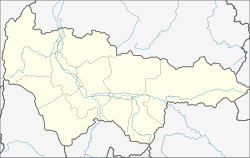Nizhnevartovsk
Нижневартовск | |
|---|---|
 Lake Komsomolskoye skyline | |
| Coordinates: 60°57′N 76°36′E / 60.950°N 76.600°E | |
| Country | Russia |
| Federal subject | Khanty-Mansi Autonomous Okrug[1] |
| Founded | 1909 |
| City status since | March 9, 1972 |
| Government | |
| • Body | City Duma[2] |
| • Mayor[3] | Dmitriy Koshenko[3] |
| Area | |
• Total | 271.319 km2 (104.757 sq mi) |
| Elevation | 45 m (148 ft) |
| Population | |
• Total | 251,694 |
| • Rank | 73rd in 2010 |
| • Density | 930/km2 (2,400/sq mi) |
| • Subordinated to | city of okrug significance of Nizhnevartovsk[1] |
| • Capital of | Nizhnevartovsky District,[1] city of okrug significance of Nizhnevartovsk[1] |
| • Urban okrug | Nizhnevartovsk Urban District[6] |
| • Capital of | Nizhnevartovsk Urban Okrug,[6] Nizhnevartovsky Municipal District[6] |
| Time zone | UTC+5 (MSK+2 |
| Postal code(s)[8] | 628600-628624 |
| Dialing code(s) | +7 3466 |
| OKTMO ID | 71875000001 |
| City Day | March 9 |
| Website | www |
Nizhnevartovsk (Russian: Нижневартовск, IPA: [nʲɪʐnʲɪˈvartəfsk]) is a city in Khanty-Mansi Autonomous Okrug–Yugra, Russia. Since the 1960s, the Western Siberian oil boom has led to Nizhnevartovsk's rapid growth from a small settlement to a city due to its location beside the Samotlor oil field along the right bank of the Ob River, 30 kilometers (19 mi) from the border with Tomsk Oblast, and the presence of the petroleum industry has made it one of the wealthiest cities in Russia.
Nizhnevartovsk is one of the few cities in Russia that exceeds the population of the administrative center of its federal subject. Population: 283,256 (2021 Census);[9] 251,694 (2010 Census);[5] 239,044 (2002 Census);[10] 241,457 (1989 Soviet census).[11]
| Year | Pop. | ±% |
|---|---|---|
| 1959 | 2,300 | — |
| 1970 | 15,663 | +581.0% |
| 1979 | 108,740 | +594.2% |
| 1989 | 241,457 | +122.0% |
| 2002 | 239,044 | −1.0% |
| 2010 | 251,694 | +5.3% |
| 2021 | 283,256 | +12.5% |
| Source: Census data | ||
- ^ a b c d e Cite error: The named reference
Ref51was invoked but never defined (see the help page). - ^ "Дума города Нижневартовска". Archived from the original on February 22, 2014. Retrieved February 28, 2014.
- ^ a b "Deputies elected a new mayor of Nizhnevartovsk" (in Russian). nv86.ru. December 3, 2021.
- ^ Социальный паспорт города Нижневартовска по состоянию на 01.01.2012 года. Официальный сайт органов местного самоуправления города Нижневартовска
- ^ a b Russian Federal State Statistics Service (2011). Всероссийская перепись населения 2010 года. Том 1 [2010 All-Russian Population Census, vol. 1]. Всероссийская перепись населения 2010 года [2010 All-Russia Population Census] (in Russian). Federal State Statistics Service.
- ^ a b c Cite error: The named reference
Ref52was invoked but never defined (see the help page). - ^ "Об исчислении времени". Официальный интернет-портал правовой информации (in Russian). June 3, 2011. Retrieved January 19, 2019.
- ^ Почта России. Информационно-вычислительный центр ОАСУ РПО. (Russian Post). Поиск объектов почтовой связи (Postal Objects Search) (in Russian)
- ^ Russian Federal State Statistics Service. Всероссийская перепись населения 2020 года. Том 1 [2020 All-Russian Population Census, vol. 1] (XLS) (in Russian). Federal State Statistics Service.
- ^ Federal State Statistics Service (May 21, 2004). Численность населения России, субъектов Российской Федерации в составе федеральных округов, районов, городских поселений, сельских населённых пунктов – районных центров и сельских населённых пунктов с населением 3 тысячи и более человек [Population of Russia, Its Federal Districts, Federal Subjects, Districts, Urban Localities, Rural Localities—Administrative Centers, and Rural Localities with Population of Over 3,000] (XLS). Всероссийская перепись населения 2002 года [All-Russia Population Census of 2002] (in Russian).
- ^ Всесоюзная перепись населения 1989 г. Численность наличного населения союзных и автономных республик, автономных областей и округов, краёв, областей, районов, городских поселений и сёл-райцентров [All Union Population Census of 1989: Present Population of Union and Autonomous Republics, Autonomous Oblasts and Okrugs, Krais, Oblasts, Districts, Urban Settlements, and Villages Serving as District Administrative Centers]. Всесоюзная перепись населения 1989 года [All-Union Population Census of 1989] (in Russian). Институт демографии Национального исследовательского университета: Высшая школа экономики [Institute of Demography at the National Research University: Higher School of Economics]. 1989 – via Demoscope Weekly.




